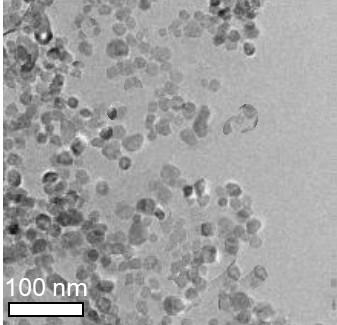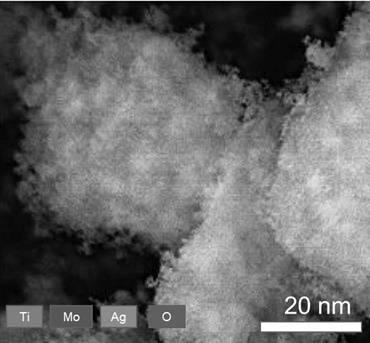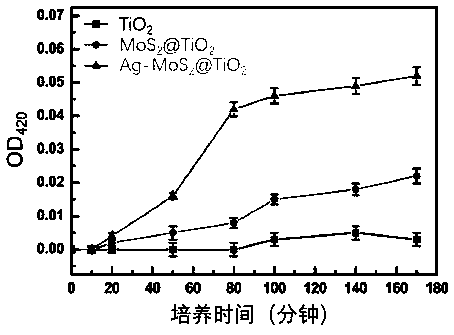Ag-MoS2@TiO2 nano photocatalytic sterilization material and preparation method thereof
A technology of nano-light and nano-titanium dioxide, which is applied in the field of preparation of MoS2 quantum dot composite TiO2 nano-photocatalytic bactericidal material, can solve the problems of limiting the killing effect of silver ions, not easy to absorb by cells, and easy to decompose when exposed to light, so as to improve quantum production. High efficiency, simple operation, and short time-consuming effect
- Summary
- Abstract
- Description
- Claims
- Application Information
AI Technical Summary
Problems solved by technology
Method used
Image
Examples
Embodiment 1
[0035] The Ag-MoS of this example 2 @TiO 2 The preparation method of nanometer photocatalytic bactericidal material comprises the following steps:
[0036] (1) Mix and grind nano-titanium dioxide, molybdenum disulfide and chitosan according to the ratio of 75:1:2 for 20 minutes to obtain mixed powder;
[0037] (2) Add N-methylpyrrolidone to the mixed powder, stir and mix to obtain a mixed solution, wherein the mass ratio of nano-titanium dioxide to N-methylpyrrolidone is 1:100;
[0038] (3) Put the mixture in an ultrasonic cleaning machine for 1 hour, and the power of ultrasonic treatment is 250W;
[0039] (4) Heat the ultrasonically treated mixture to 120°C and react for 2.5 hours;
[0040] (5) Add AgNO to the reaction solution in step (4) 3 The solution was stirred at room temperature for 1 hour at a stirring speed of 500 rpm, wherein AgNO 3 Ag in solution + The concentration is 1000ppm;
[0041] (6) Evaporate the heat-treated mixed solution at 100°C until it becomes ...
Embodiment 2
[0047] The main technical solution of this embodiment is basically the same as that of Embodiment 1, and the features not explained in this embodiment are explained in Embodiment 1, and will not be repeated here. The difference between this embodiment and embodiment 1 is:
[0048] (1) Grinding nano titanium dioxide, molybdenum disulfide and chitosan for 30 minutes to obtain mixed powder;
[0049] (2) The mass ratio of nano-titanium dioxide to N-methylpyrrolidone is 1:1000;
[0050] (3) Ultrasonic treatment for 0.5 hours, the power of ultrasonic treatment is 200W;
[0051] (4) Heat treatment to 110°C and react for 2 hours;
[0052] (5) Add AgNO 3 The solution was stirred at room temperature for 50 minutes
[0053] (6) Evaporate to dryness at 80°C until it becomes powder.
Embodiment 3
[0055] The main technical solutions of this embodiment are basically the same as those of Embodiment 1 or Embodiment 2, and the features not explained in this embodiment are explained in Embodiment 1 or Embodiment 2, and will not be repeated here. The difference between this embodiment and embodiment 1 is:
[0056] (1) Grinding nano titanium dioxide, molybdenum disulfide and chitosan for 10 minutes to obtain mixed powder;
[0057] (2) The mass ratio of nano titanium dioxide to N-methylpyrrolidone is 1:10;
[0058] (3) Ultrasonic treatment for 2 hours, the power of ultrasonic treatment is 300W;
[0059] (4) Heat treatment to 140°C and react for 4 hours;
[0060] (5) Add AgNO 3 The solution was stirred at room temperature for 70 minutes
[0061] (6) Evaporate to dryness at 90°C until it becomes powder.
PUM
 Login to View More
Login to View More Abstract
Description
Claims
Application Information
 Login to View More
Login to View More - R&D
- Intellectual Property
- Life Sciences
- Materials
- Tech Scout
- Unparalleled Data Quality
- Higher Quality Content
- 60% Fewer Hallucinations
Browse by: Latest US Patents, China's latest patents, Technical Efficacy Thesaurus, Application Domain, Technology Topic, Popular Technical Reports.
© 2025 PatSnap. All rights reserved.Legal|Privacy policy|Modern Slavery Act Transparency Statement|Sitemap|About US| Contact US: help@patsnap.com



